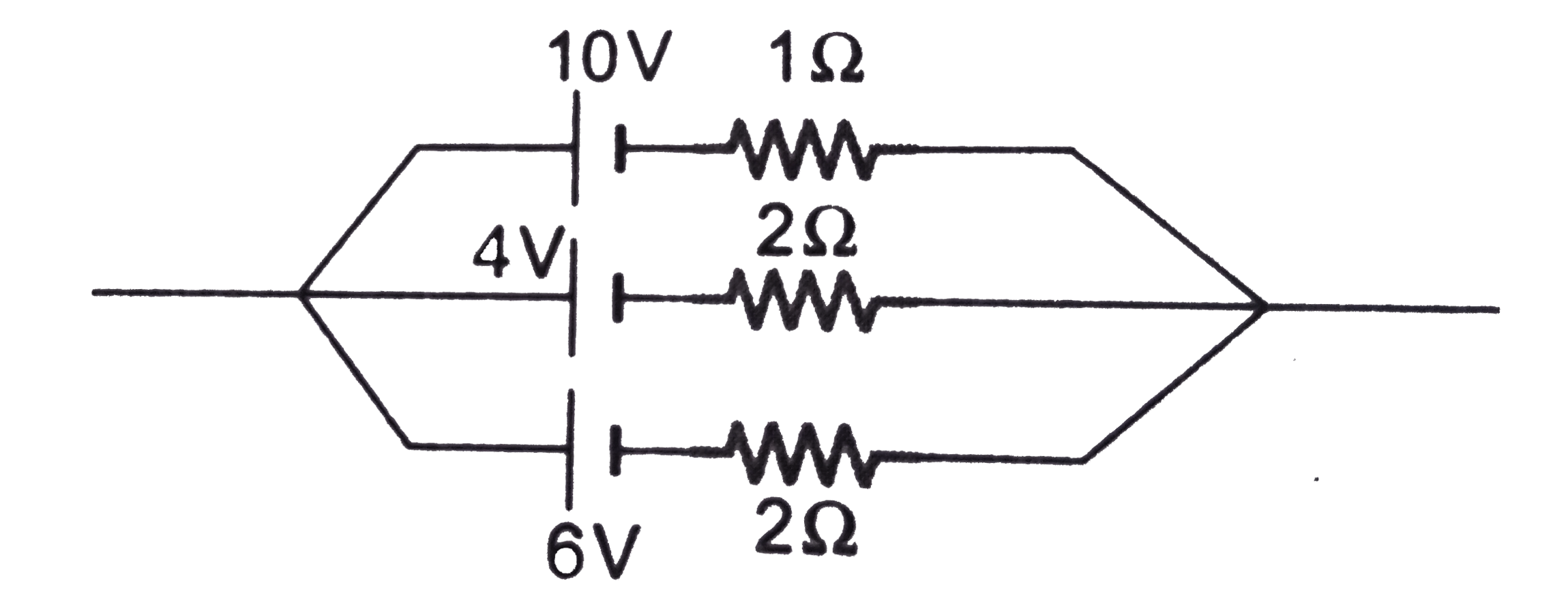the nonideal batteries are connected in series. Consider the following statements :
(A)The equivalent emf is larger than either of the two emfs.
(B) the equivalent internal resistances is smaller than either of the two internal resistances.
(Each of A and B is correct.
(b)A is correct but B is worng
(c )B is correct but A is worng
(d)each of A and B are worng
The correct Answer is:B
To solve the problem regarding the non-ideal batteries connected in series, we will analyze the statements given:
1. Understanding Equivalent EMF in Series:
- When batteries are connected in series, the total or equivalent electromotive force (EMF) is the sum of the individual EMFs of the batteries.
- If we have two batteries with EMFs E1 and E2, then the equivalent EMF Eeq can be expressed as:
Eeq=E1+E2
- Since Eeq is the sum of E1 and E2, it is clear that:
Eeq>E1andEeq>E2
- Therefore, statement (A) is true.
2. Understanding Equivalent Internal Resistance in Series:
- The internal resistances of batteries in series add up, similar to how EMFs add up.
- If the internal resistances of the two batteries are R1 and R2, then the equivalent internal resistance Req can be expressed as:
Req=R1+R2
- Since Req is the sum of R1 and R2, it follows that:
Req>R1andReq>R2
- Therefore, statement (B) is false.
3. Conclusion:
- From our analysis, we conclude that statement (A) is correct and statement (B) is incorrect.
Final Answer:
- Statement (A) is true: The equivalent EMF is larger than either of the two EMFs.
- Statement (B) is false: The equivalent internal resistance is not smaller than either of the two internal resistances.
- When batteries are connected in series, the total or equivalent electromotive force (EMF) is the sum of the individual EMFs of the batteries.
- If we have two batteries with EMFs E1 and E2, then the equivalent EMF Eeq can be expressed as:
Eeq=E1+E2
- Since Eeq is the sum of E1 and E2, it is clear that:
Eeq>E1andEeq>E2
- Therefore, statement (A) is true.
- The internal resistances of batteries in series add up, similar to how EMFs add up.
- If the internal resistances of the two batteries are R1 and R2, then the equivalent internal resistance Req can be expressed as:
Req=R1+R2
- Since Req is the sum of R1 and R2, it follows that:
Req>R1andReq>R2
- Therefore, statement (B) is false.
- From our analysis, we conclude that statement (A) is correct and statement (B) is incorrect.
- Statement (A) is true: The equivalent EMF is larger than either of the two EMFs.
- Statement (B) is false: The equivalent internal resistance is not smaller than either of the two internal resistances.
Topper's Solved these Questions
- ELECTRIC CURRENT IN CONDUCTORSBOOK - HC VERMA ENGLISHCHAPTER - ELECTRIC CURRENT IN CONDUCTORSEXERCISE - objective 2
9 Videos
- ELECTRIC CURRENT IN CONDUCTORSBOOK - HC VERMA ENGLISHCHAPTER - ELECTRIC CURRENT IN CONDUCTORSEXERCISE - Exercises
84 Videos
- ELECTRIC CURRENT IN CONDUCTORSBOOK - HC VERMA ENGLISHCHAPTER - ELECTRIC CURRENT IN CONDUCTORSEXERCISE - worked out Example
33 Videos
- DISPERSION AND SPECTRABOOK - HC VERMA ENGLISHCHAPTER - DISPERSION AND SPECTRAEXERCISE - Question for short Answer
6 Videos
- ELECTRIC CURRENT THROUGH GASESBOOK - HC VERMA ENGLISHCHAPTER - ELECTRIC CURRENT THROUGH GASESEXERCISE - Short answer
6 Videos
Similar Questions
the two nonideal batteries are connected in series. Consider the following statements :
(A)The equivalent emf is larger than either of the two emfs.
(B) the equivalent internal resistances is smaller than either of the two internal resistances.
View SolutionTwo nonideal batteries are connected in parallel. Consider the following statements:
(A)The equivalent emf is smaller than either of the two emfs.
(B) The equivalent internal resistance is smaller than either of the two internal resistances.
View Solution
Knowledge Check
If n cells each of emf E and internal resistance rare connected in parallel, then the total emf and internal resistances will be
Aε,rnBε,nrCnε,rnDnε,nr
Two nonideal batteries are connected in parallel. Consider the following statements:
(A)The equivalent emf is smaller than either of the two emfs.
(B) The equivalent internal resistance is smaller than either of the two internal resistances.
View SolutionTwo nonideal batteries are connected in parallel. Consider the following statements:
(A)The equivalent emf is smaller than either of the two emfs.
(B) The equivalent internal resistance is smaller than either of the two internal resistances.
View SolutionAssertion : Two non-ideal batteries are connected in parallel with same polarities on same: side. The equivalent emf is smaller than either of the two emfs.
Reason : Two non-ideal batteries are connected in parallel, the equivalent inter resistance is smaller than either of the two internal resistances.
View SolutionIf three cell are connected in parallel then equivalent emf……. and equivalent internal resistance is …..

View SolutionState how are the two resistors joined with a battery in each of the following cases when :
equivalent resistance is less than either of the two resistances,
View SolutionState how are the two resistors joined with a battery in each of the following cases when :
equivalent resistance is more than either of the two resistances.
View SolutionFind the equivalent emf and internal resistance of the arrangement shown in figure.

View Solution
